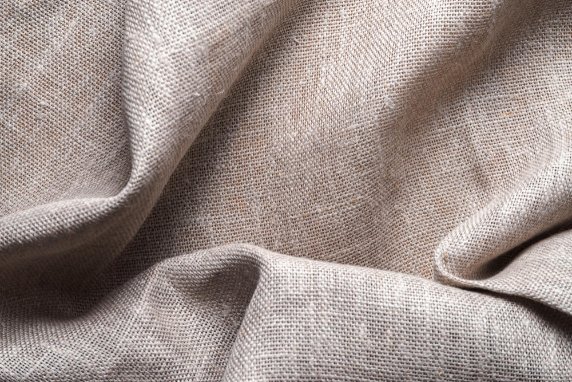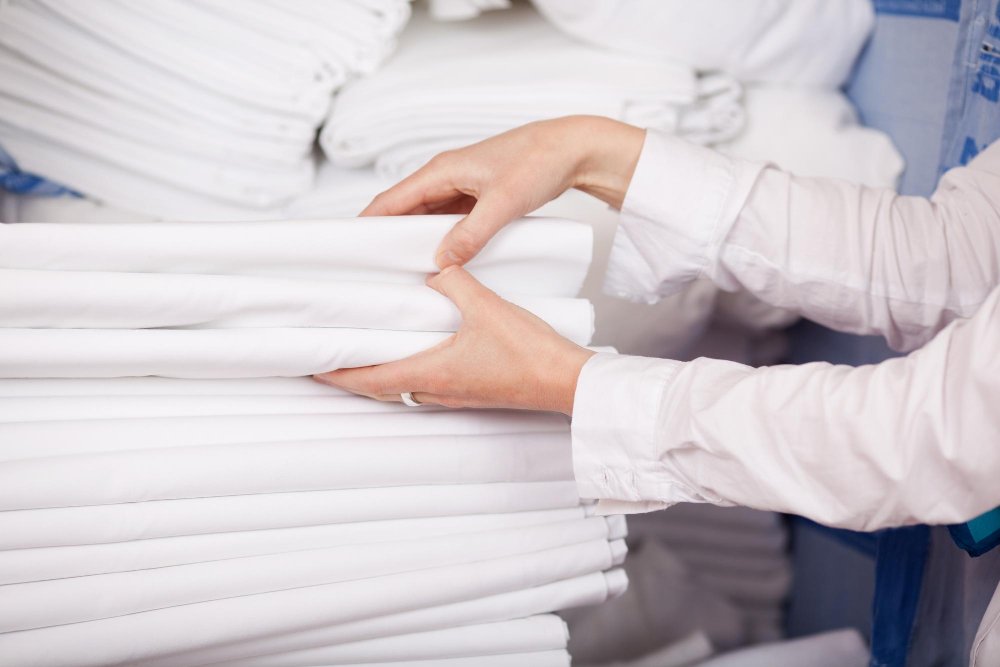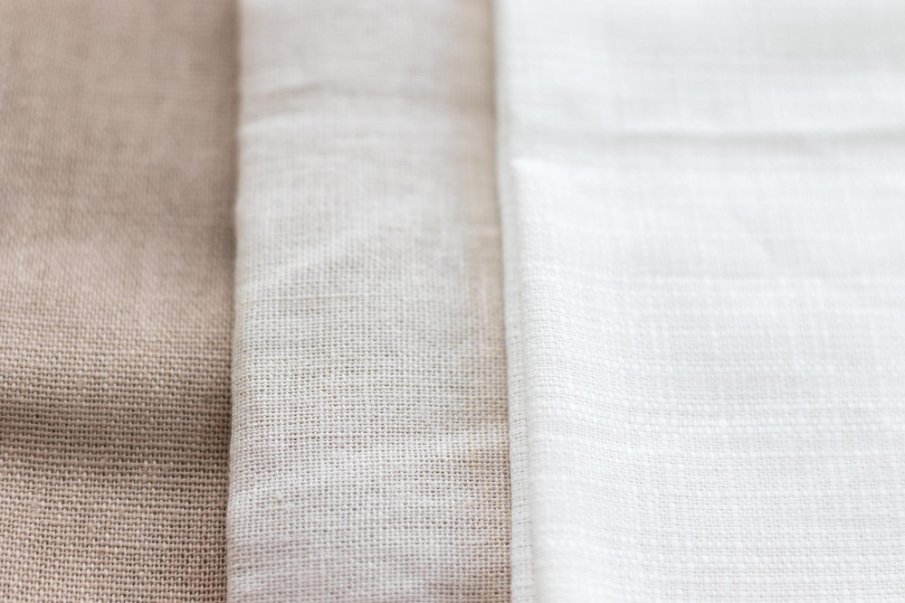Discover everything about this premium textile from its French origins to modern applications in clothing and home décor
Last Updated: October 24, 2025
Quick Summary
Cambric linen is a finely woven, lightweight fabric that started in 16th-century France. It features a tight plain-weave structure with 60-80 threads per inch, creating a smooth surface that’s perfect for summer clothing, elegant table linens, and detailed embroidery work. While more expensive than standard linen fabric, it offers better wrinkle resistance, immediate softness, and a refined appearance that makes it worth the investment for quality-conscious buyers.
Table of Contents
- What is Cambric Linen Fabric?
- Historical Background and Evolution
- Physical Characteristics and Weave Structure
- Cambric vs. Batiste vs. Chambray: Understanding the Differences
- How Cambric Compares to Other Fabrics
- Advantages and Disadvantages of Cambric Linen
- Technical Specifications and Testing Standards
- Applications in Clothing and Home Décor
- Is Cambric a Summer or Winter Fabric?
- How to Identify Quality Cambric
- Care and Maintenance Guide
- Buying Guide and Price Information
- Common Problems and Solutions
- Frequently Asked Questions
- Final Thoughts
What is Cambric Linen Fabric?
Cambric linen is a tightly woven, lightweight fabric known for its smooth surface and refined appearance. The name comes from Cambrai, a city in northern France where skilled weavers perfected this textile during the 1500s. Today, you’ll find cambric made from linen, cotton, or a blend of both fibers.
The defining feature is its tight plain-weave structure, where threads cross over and under each other in a simple pattern. This creates a fabric that’s significantly smoother than regular linen while maintaining excellent breathability. The manufacturing process includes calendering, where heated rollers press the fabric to create a subtle sheen without synthetic coatings.
Modern cambric typically ranges from 60 to 80 threads per inch, measured using the ASTM D3775 standard. This thread count sits in the sweet spot where the fabric stays light and breathable but gains enough density for durability and a refined drape.
Historical Background and Evolution
The fabric’s journey began in 16th-century Cambrai, where the Flemish term “Kameryk” referred to this special weaving technique. European nobility prized early cambric for its combination of delicacy and strength. By the 1700s, the fabric had become a status symbol, used for shirts, handkerchiefs, and intimate apparel among wealthy families.
When England banned French fabric imports in the mid-1700s, manufacturers turned to Indian cotton. This shift brought cotton cambric into the market, making the fabric more accessible to middle-class buyers. The term “Scotch cambric” emerged to describe these cotton versions, which were produced in Scottish mills.
Throughout the 1800s, cambric evolved from purely linen construction to include cotton and cotton-linen blends. American mills began producing cambric using high-quality cotton from the South, while European makers continued their linen traditions. This diversification helped the fabric maintain popularity as production costs decreased.
Today’s cambric production combines traditional weaving methods with modern quality control. Manufacturers follow strict protocols from organizations like ASTM International and ISO to ensure consistent quality across different production facilities.
Physical Characteristics and Weave Structure
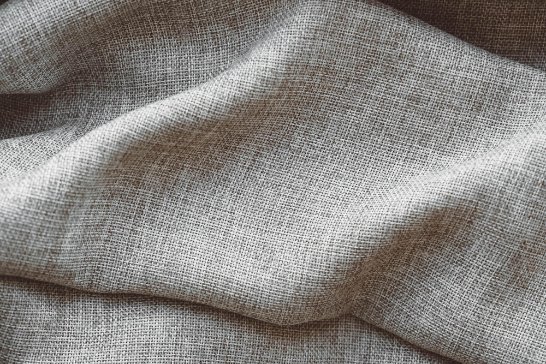
Cambric’s structure explains why it performs differently than other lightweight fabrics. The tight plain weave means each warp thread (running lengthwise) crosses over one weft thread (running crosswise) before going under the next. This creates maximum thread intersections per square inch, resulting in a smooth, stable fabric.
Key Physical Properties
The calendering process happens after weaving. Fabric passes through heated rollers that flatten and compress the threads. This mechanical finishing creates the characteristic smooth hand feel and subtle sheen that sets cambric apart from untreated linen. Unlike chemical treatments, calendering doesn’t add coatings that might wash away over time.
Natural fibers in cambric allow superior moisture management compared to synthetics. The fabric can absorb up to 20% of its weight in moisture before feeling damp, making it comfortable in humid conditions. Air circulation through the weave helps regulate body temperature, though the tighter weave means slightly less airflow than loose-weave linen.
Cambric vs. Batiste vs. Chambray: Understanding the Differences
These three terms often create confusion because they’re sometimes used interchangeably, but they actually describe different fabrics with distinct characteristics.
Cambric
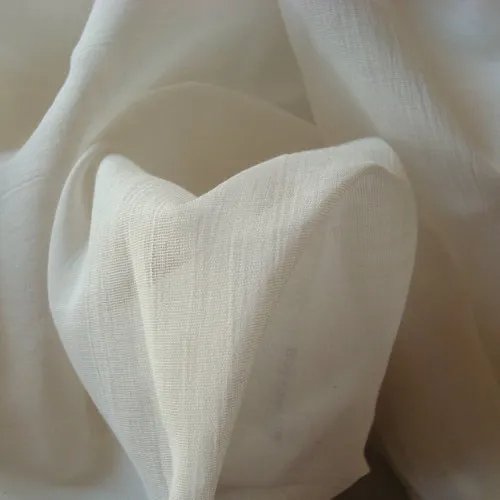
A tightly woven fabric with a calendered finish that creates a smooth surface and subtle sheen. Can be made from linen, cotton, or blends. Thread count typically ranges from 60-80 per inch. The plain weave structure and calendering process are defining features.
Batiste
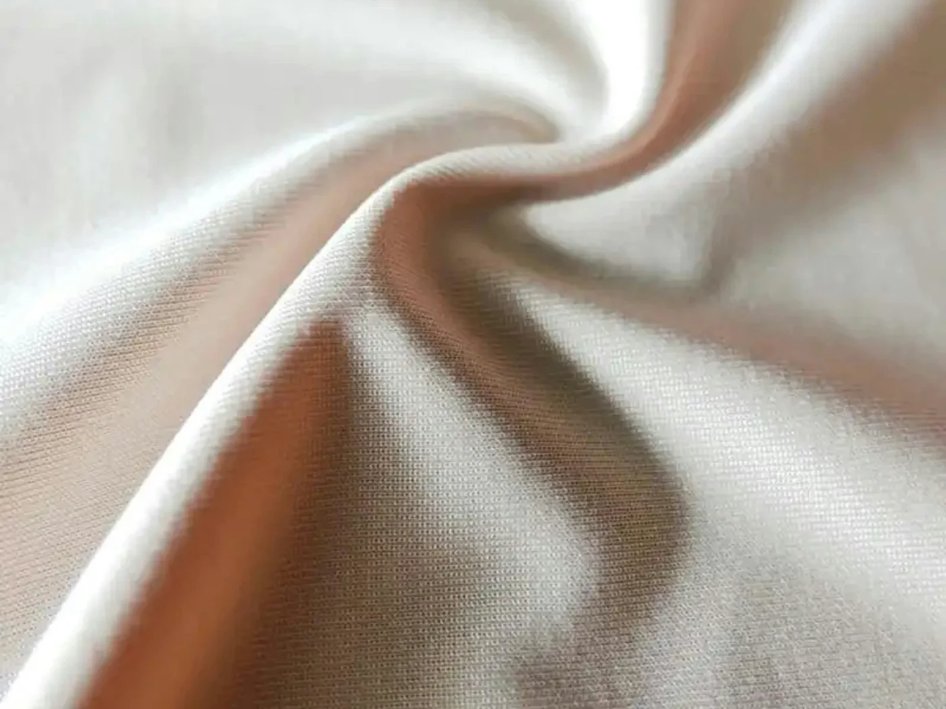
The French term for cambric, though some textile experts make a distinction. When differentiated, batiste typically refers to a lighter weight fabric with an even finer thread count (often 80-100+ threads per inch). It may skip the calendering process, resulting in a softer drape without the characteristic sheen. Most commonly made from cotton today.
Chambray
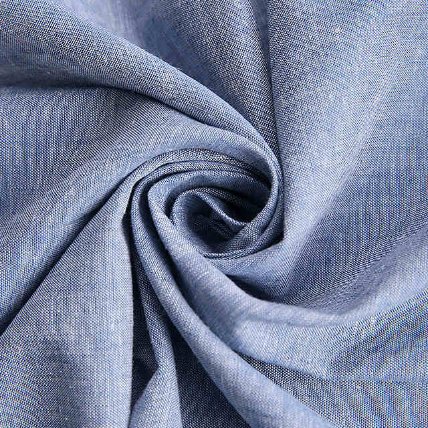
A completely different construction method. Chambray uses colored threads in the warp direction and white threads in the weft direction. This creates a fabric with different appearances on each side. While it shares the plain-weave structure, chambray looks more like lightweight denim with its characteristic color variation. It doesn’t receive calendering treatment.
| Feature | Cambric | Batiste | Chambray |
|---|---|---|---|
| Thread Arrangement | Single color warp and weft | Single color warp and weft | Colored warp, white weft |
| Surface Finish | Calendered (glossy) | Natural or lightly finished | Natural (no calendering) |
| Thread Count | 60-80 per inch | 80-100+ per inch | 40-60 per inch |
| Typical Fiber | Linen, cotton, or blends | Primarily cotton | Cotton |
| Visual Appearance | Smooth, subtle sheen | Matte, very smooth | Textured color effect |
| Common Uses | Shirts, handkerchiefs, table linens | Delicate blouses, baby clothes | Casual shirts, dresses |
How Cambric Compares to Other Fabrics
Cambric vs. Standard Linen
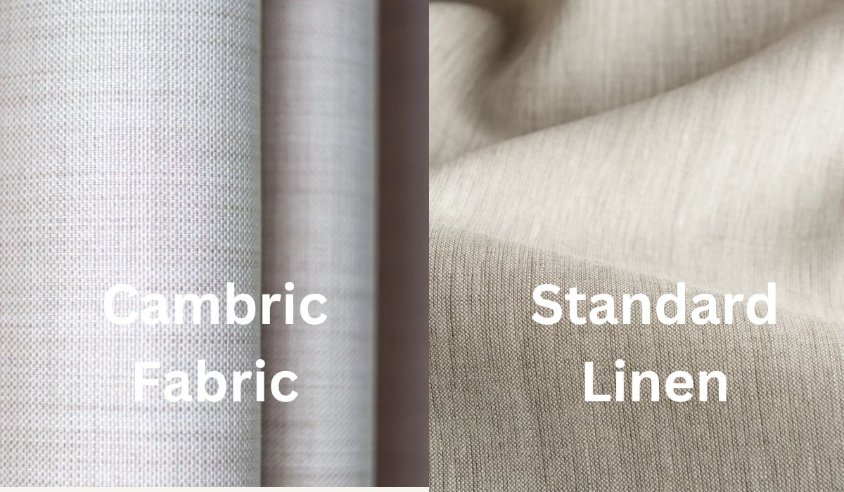
Regular linen and cambric linen come from the same flax plant but diverge during manufacturing. Standard linen uses a looser weave that creates the rustic texture many people associate with linen fabric. This looser construction gives it a natural, relaxed appearance but also means more wrinkling.
Cambric linen’s tighter weave and calendering process result in immediate smoothness, while standard closely-woven linen takes multiple washings to soften. Standard linen typically offers slightly better breathability due to more open spaces between threads, making it ideal for hot, dry climates. However, cambric provides a more polished look suitable for formal occasions.
Durability testing shows standard linen withstands abrasion better in high-friction applications like upholstery. The thicker yarns and sturdy construction of traditional linen excel in heavy-use scenarios. Cambric, designed for garments and fine textiles, focuses on comfort and appearance rather than maximum durability.
Cambric vs. Cotton
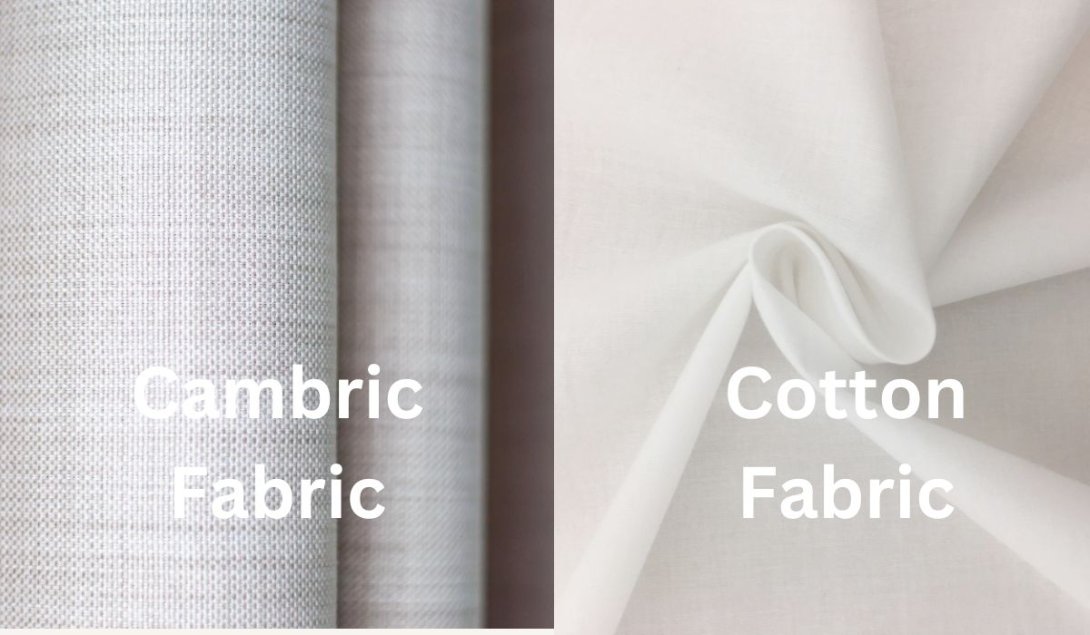
Cotton cambric shares the tight weave structure but uses cotton fibers instead of flax. This creates important performance differences. Cotton cambric typically costs less than linen cambric while offering similar comfort for everyday wear.
Moisture management differs between the two. Linen cambric absorbs moisture more quickly and dries faster than cotton cambric, making it better for humid environments. Cotton cambric feels softer initially but may lose shape more easily over time. Linen maintains its structure better through repeated washing.
Temperature regulation favors linen cambric in warm weather. The flax fibers have natural cooling properties that cotton can’t match. However, cotton cambric works better in moderate temperatures where extreme breathability isn’t needed. Many manufacturers now blend the two fibers to capture benefits from both materials.
Cambric vs. Synthetic Materials
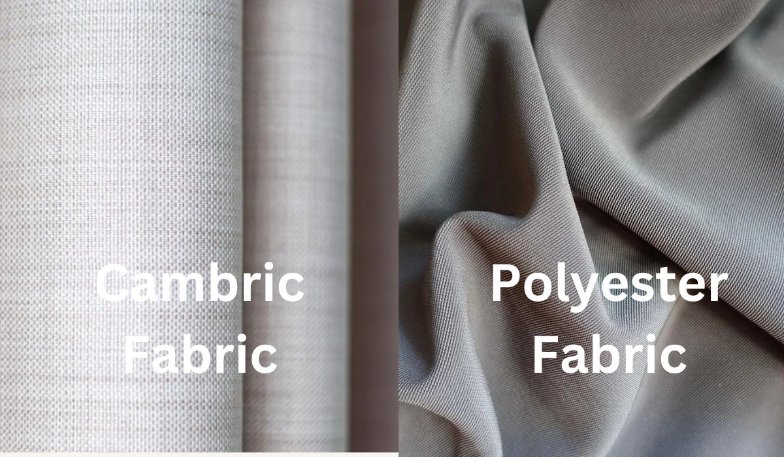
Comparing natural cambric to synthetic alternatives reveals clear performance gaps. Polyester and other synthetics cost less and resist wrinkles better, but they trap moisture and heat against the skin. Cambric’s natural fibers wick perspiration away from the body, while synthetics tend to hold moisture, creating discomfort.
Heat regulation measurements show natural fibers outperform synthetics significantly. In laboratory tests using thermal manikins, linen and cotton fabrics demonstrate better heat dissipation than polyester blends. This translates to feeling cooler in summer heat when wearing cambric compared to synthetic fabrics.
Environmental considerations also matter. Natural cambric biodegrades after its useful life, while synthetic materials persist in landfills for decades. However, synthetic production costs less energy initially, creating a trade-off between immediate manufacturing impact and long-term waste concerns. For more on this topic, check out our comparison of natural versus synthetic fabrics.
Advantages and Disadvantages of Cambric Linen
Like any fabric, cambric linen has strengths and limitations that determine whether it’s the right choice for your project.
Advantages
- Immediate softness – No break-in period needed unlike regular linen
- Smooth texture – Perfect for detailed embroidery and delicate work
- Better wrinkle resistance – Compared to standard linen fabrics
- Excellent breathability – Keeps you cool in warm weather
- Moisture wicking – Pulls perspiration away from skin
- Natural temperature regulation – Adapts to your body heat
- Refined appearance – Subtle sheen adds elegance
- Hypoallergenic properties – Gentle on sensitive skin
- Biodegradable – Environmentally friendly at end of life
- Ages gracefully – Becomes softer with washing
Disadvantages
- Higher cost – More expensive than standard cotton or synthetic fabrics
- Requires careful washing – Cold water and gentle cycles needed
- Initial shrinkage – Expect 3-5% shrinkage after first wash
- Still wrinkles – Better than regular linen but not wrinkle-free
- Limited color fastness – Dyed versions may fade with sun exposure
- Fray-prone edges – Raw edges need finishing in sewing projects
- Not ideal for heavy-duty use – Better for garments than upholstery
- Availability – Harder to find than common cotton fabrics
- Professional cleaning costs – Some items require dry cleaning
Is Cambric Fabric Good or Bad?
The answer depends entirely on your needs. Cambric excels as a summer clothing fabric, table linen material, and base for embroidery projects. Its smooth texture and refined appearance make it perfect for formal shirts, elegant blouses, and quality handkerchiefs. The natural breathability and moisture management justify the higher cost for hot weather wardrobes.
However, cambric isn’t the best choice for every situation. If you need fabric for heavy upholstery, outdoor gear, or children’s play clothes that will take serious abuse, other materials work better. The delicate nature and care requirements make cambric impractical for rough use. Think of cambric as the “dress shoes” of fabrics – beautiful and comfortable for the right occasions, but not for hiking through mud.
Technical Specifications and Testing Standards
Understanding the technical side helps you evaluate quality and compare products. Professional textile testing follows standards set by ASTM International and other organizations. These standardized testing protocols ensure manufacturers can guarantee performance and allow buyers to compare products objectively.
Standard Test Methods for Cambric
When purchasing quality cambric, ask suppliers about their testing protocols and certification compliance. Reputable manufacturers provide test results based on these industry-standard methods.
Applications in Clothing and Home Décor
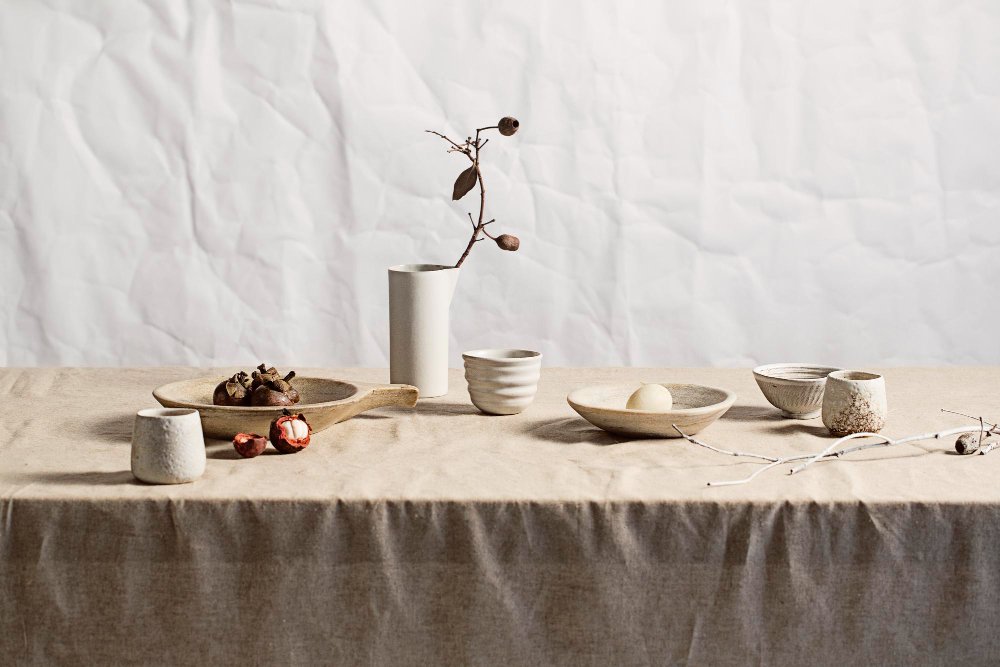
Cambric’s unique properties make it suitable for specific uses where its combination of smoothness, breathability, and refined appearance shine.
Clothing Applications
Summer shirts and blouses represent cambric’s ideal use case. The fabric’s breathability prevents overheating while the smooth surface resists clinging to skin. Tailored dress shirts made from cambric maintain a crisp appearance through a long workday without feeling heavy or restrictive.
Lightweight dresses and skirts benefit from cambric’s drape qualities. The fabric flows naturally without being too stiff or too limp. Wedding attire and special occasion clothing often use cambric because it photographs well and feels comfortable during extended wear. If you’re interested in garment construction, our guide on how to sew a dress covers techniques that work well with cambric.
Baby clothing designers favor cambric for its gentle touch against sensitive skin. The hypoallergenic properties and natural breathability make it safe and comfortable for infant wear. Christening gowns and heirloom pieces traditionally use fine cambric because it supports detailed embroidery and lace applications.
Undergarments and intimate apparel made from cambric offer comfort without synthetic materials. The moisture-wicking properties prevent dampness buildup, while the smooth surface prevents irritation. Vintage and reproduction historical costume makers particularly appreciate cambric for period-accurate foundations and under layers.
Home Décor Uses
Table linens made from cambric add sophistication to dining settings. The fabric’s resistance to food stains (when properly treated) and ease of laundering make it practical for regular use. Napkins fold crisply and hold their shape through meals, while tablecloths drape elegantly without overwhelming table settings.
Lightweight curtains using cambric filter daylight beautifully while maintaining privacy. The semi-sheer quality creates a soft glow in rooms without blocking all natural light. Unlike heavier drapes, cambric curtains move gently with air currents, creating a relaxed atmosphere. They work particularly well in warmer climates where insulating window treatments aren’t necessary.
Decorative pillowcases and throw pillow covers showcase cambric’s smooth surface. The fabric takes dye well, allowing for vibrant colors or subtle pastels. Embroidered accent pillows made on cambric remain popular because the tight weave supports detailed needlework without puckering. For those interested in textile arts, cambric pairs beautifully with various lace fabrics for mixed-media projects.
Dust covers for furniture and stored textiles benefit from cambric’s breathable yet protective qualities. The fabric allows air circulation that prevents mustiness while keeping dirt and dust away from valuable items. Museums and collectors often use unbleached cambric for long-term storage of historic textiles because it won’t trap moisture or off-gas harmful chemicals.
Planning Your Project?
Calculate exactly how much cambric fabric you need with our fabric yardage calculator. This free tool helps you avoid buying too much or too little fabric for your sewing projects.
Is Cambric a Summer or Winter Fabric?
Cambric is primarily a summer and warm-weather fabric, though understanding why helps you use it effectively year-round.
Summer Performance
The lightweight nature and excellent breathability make cambric ideal for hot weather. Natural linen fibers conduct heat away from the body more effectively than cotton or synthetics. When temperatures climb above 80°F (27°C), cambric’s moisture-wicking properties become especially noticeable. Perspiration moves through the fabric rather than saturating it, preventing that clammy feeling common with non-breathable materials.
The smooth surface of cambric has an added benefit in heat – it doesn’t cling to skin like some fabrics. Air can circulate between the fabric and body, enhancing the cooling effect. This makes cambric shirts and dresses more comfortable than similar-weight fabrics that stick when you sweat.
Transitional Season Use
Spring and fall temperatures suit cambric well. In moderate weather (60-75°F / 15-24°C), the fabric provides just enough coverage without feeling heavy. Layer cambric pieces under cardigans or light jackets for cooler mornings, then wear alone as temperatures rise. The fabric’s drape makes it easy to wear under other garments without adding bulk.
Winter Limitations
Cambric doesn’t provide insulation for cold weather. The same breathability that keeps you cool in summer allows heat to escape rapidly when temperatures drop. While you could technically wear cambric year-round as a base layer, you’ll need substantial outer layers to stay warm. Unlike flannel or heavier materials designed for cold weather, cambric won’t trap body heat effectively.
However, cambric has a place in winter wardrobes for indoor wear. In heated buildings where temperatures stay comfortable, cambric shirts and blouses prevent overheating. The breathability that’s too much for outdoor winter wear becomes perfect for office environments with strong heating systems.
How to Identify Quality Cambric
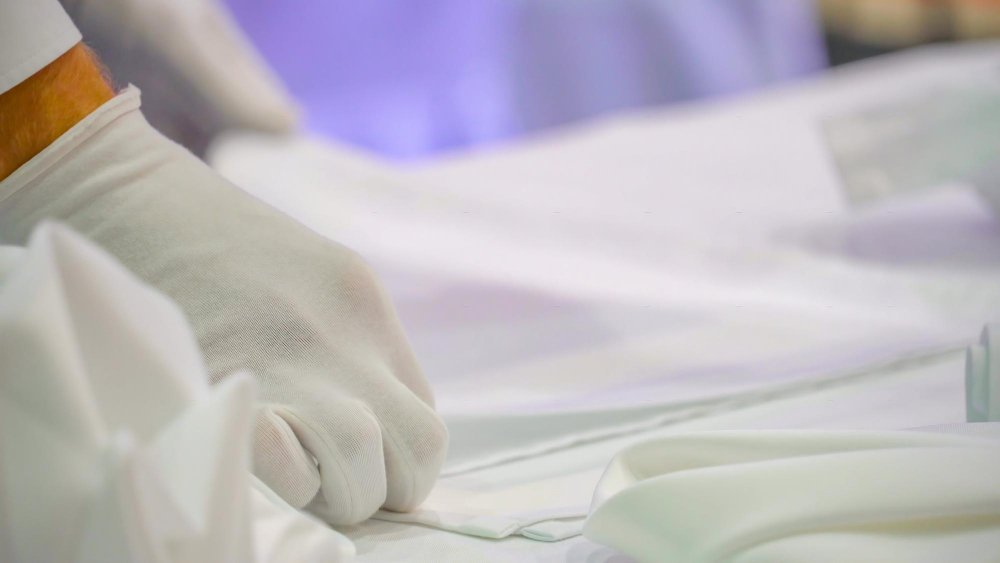
Not all cambric offers the same quality level. Learning to evaluate fabric before purchasing helps ensure you get good value.
Visual Inspection
Hold the fabric up to light. Quality cambric shows an even, consistent weave with no thin spots or irregularities. The thread density should look uniform across the entire piece. Variations in transparency suggest inconsistent yarn sizes or weaving errors.
Check the surface finish. Good calendering creates a subtle, even sheen without obvious roller marks or streaks. The glossy effect should be consistent across both sides (though one side may show slightly more sheen). Excessive shine suggests too much calendering or chemical treatments.
Examine the selvage edges. Professional manufacturing produces clean, tight selvages without loose threads or fraying. The selvage tells you about overall production quality – sloppy edge finishing often indicates other quality issues.
Touch and Drape Test
Quality cambric feels smooth but not slippery. Run your hand across the surface in different directions. The fabric should have a consistent hand feel without rough patches. Any snags or catches indicate lower thread quality or inconsistent weaving.
Test the drape by letting fabric hang freely. Quality cambric hangs in soft folds without excessive stiffness or limpness. The fabric should support its own weight without collapsing but also flow naturally when moved. Overly stiff cambric suggests heavy sizing that will wash out, while limp fabric may lack proper thread density.
Thread Count Verification
If possible, use a thread counter (a small magnifying tool with a measuring grid) to verify the stated thread count. Count threads in a one-inch square area. Quality cambric should have 60-80 threads per inch total (warp plus weft threads combined). Manufacturers sometimes inflate thread counts on labels, so verification protects you from false advertising.
Fiber Content Check
Read the fiber content label carefully. “100% linen” or “100% cotton” indicates pure cambric. Blends should state exact percentages. Be wary of vague terms like “linen-look” or “linen-touch,” which often mean synthetic fabrics designed to mimic linen’s appearance without using actual flax fibers. The International Organization for Standardization provides guidelines for proper fiber content labeling.
A simple burn test (done carefully with a tiny snip from the selvage) can verify natural fibers. Linen and cotton burn cleanly, leaving soft gray ash and smelling like burning paper. Synthetics melt into hard beads and smell like plastic. Never burn test fabric while wearing it or near flammable materials.
Not Sure About Your Fabric Type?
Try our linen quality quiz to test your knowledge and learn what to look for when shopping for quality natural fabrics. It only takes a few minutes and provides personalized tips based on your responses.
Care and Maintenance Guide
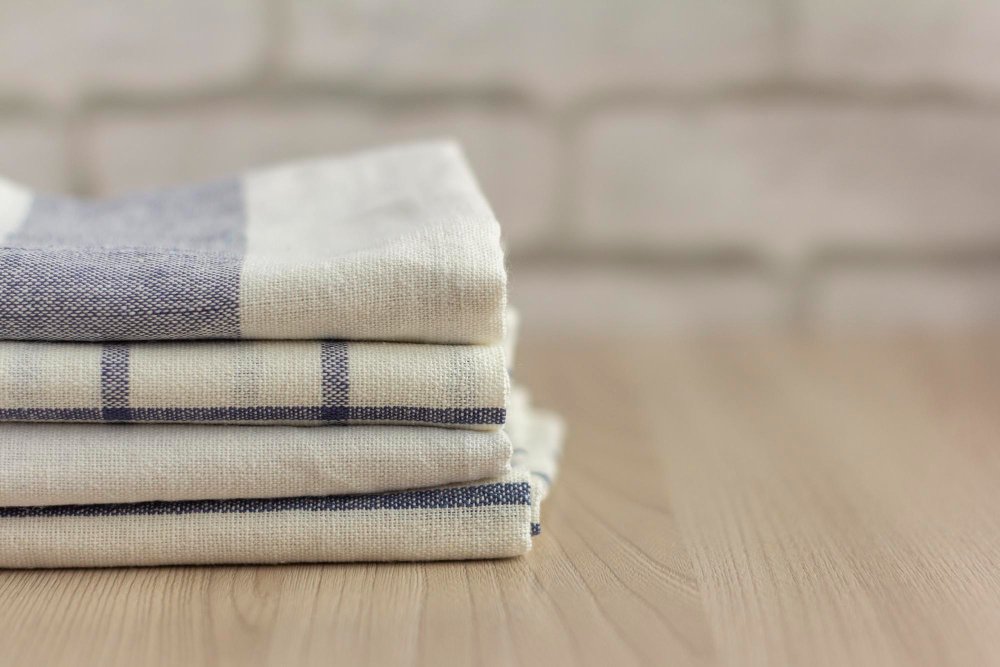
Proper care protects your investment and extends the life of cambric items. The good news is that cambric requires less fussy maintenance than its delicate appearance might suggest.
Step-by-Step Washing Instructions
Storage Best Practices
Store clean, completely dry cambric items in a cool, dark place with good air circulation. Fold along natural creases rather than creating sharp folds that could become permanent. For long-term storage, wrap items in acid-free tissue paper rather than plastic bags, which trap moisture.
Avoid storing cambric with cedar products or mothballs. The oils from cedar can stain fabric, while mothball chemicals may damage fibers. For more storage tips specific to natural fabrics, check our seasonal fabric storage guide.
Stain Removal Strategies
Act quickly when spills occur. Blot (don’t rub) liquid spills immediately with clean cloth. For common stains:
Coffee and tea – Rinse with cold water from the back of the fabric. Apply diluted white vinegar (1 part vinegar to 3 parts water) to neutralize the stain. Wash normally.
Grease and oil – Sprinkle cornstarch or talcum powder on the stain to absorb oil. Let sit for 30 minutes, then brush off. Apply a small amount of dish soap directly to the spot before washing.
Wine – Pour salt on red wine stains immediately to absorb liquid. Rinse with cold water. If the stain persists, try club soda or a paste of baking soda and water before washing.
Ink – Dab (don’t rub) with rubbing alcohol using a cotton swab. Work from the outside of the stain toward the center to prevent spreading. Test on an inconspicuous area first to ensure the alcohol doesn’t affect dye.
Professional Cleaning Considerations
Some cambric items benefit from professional cleaning, particularly structured garments with interfacing or those with delicate embellishments. Dry cleaners use solvents that clean without water, preventing shrinkage issues. However, frequent dry cleaning can be harsh on natural fibers.
If taking items to a cleaner, specify “no starch” unless you want extra stiffness. Traditional dry cleaning starch contains chemicals that yellow with age. Request green or eco-friendly cleaning methods when available, as these use gentler solvents.
Create Your Custom Care Schedule
Our linen care calculator generates personalized washing instructions based on your specific fabric type, local water hardness, and washing machine settings. Get recommendations tailored to your situation.
Buying Guide and Price Information
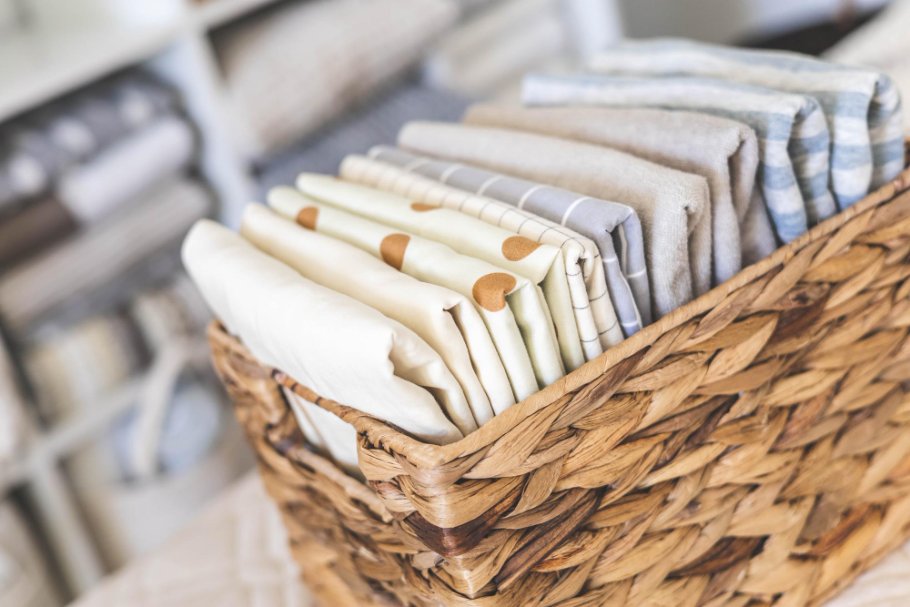
Understanding cambric pricing and where to purchase helps you make informed buying decisions.
Price Ranges
Expect to pay $12-30 per yard for quality cambric fabric from retail sources. Premium Belgian or Irish linen cambric can reach $35-50 per yard. Cotton cambric typically costs less, ranging from $8-18 per yard. These prices reflect mid-2025 market conditions and vary based on fiber content, origin, and supplier.
Ready-made garments show wider price variation. A quality cambric shirt might cost $60-150 from mainstream brands, while luxury or designer pieces can exceed $300. Table linens typically run $40-80 for a set of four napkins, with tablecloths ranging from $80-200 depending on size.
Wholesale prices drop significantly for bulk orders. If you need large quantities for a business or major project, expect discounts of 30-50% when ordering 50+ yards. Some mills require minimum orders but offer the best prices for serious buyers.
Where to Buy
Fabric stores – Local shops let you examine fabric in person before purchasing. Staff can often provide guidance on care and suitability. However, selection may be limited and prices tend to be higher than online sources.
Online fabric retailers – Wide selection and competitive pricing make online shopping attractive. Read reviews carefully and order samples when available. Factor in shipping costs and return policies. Reputable sites provide detailed specifications including thread count and fiber content.
Direct from mills – Buying directly from textile manufacturers offers the best prices but requires larger minimum orders. This works well for businesses or group purchases. Mills can also customize products to your specifications.
Vintage and second-hand sources – Antique shops, estate sales, and online marketplaces sometimes offer vintage cambric at reasonable prices. Older fabric may have superior quality but check carefully for damage, stains, or deterioration. Vintage handkerchiefs and table linens provide affordable ways to experience high-quality cambric.
What to Look for When Shopping
Request fabric specifications in writing. Reputable sellers provide thread count, weight (in GSM), fiber content percentages, and width. Be skeptical of listings that lack this basic information.
Ask about return policies before purchasing. Fabric can look different in person than in photos due to lighting and screen variations. Good suppliers allow returns of uncut fabric within a reasonable timeframe.
Check for certifications if sustainable production matters to you. OEKO-TEX Standard 100 certification indicates the fabric is free from harmful chemicals. GOTS (Global Organic Textile Standard) certification verifies organic production methods. While certified fabric costs more, it guarantees certain production standards.
Compare shipping costs carefully. Heavy fabric shipments can cost more to ship than the fabric itself. Some suppliers offer free shipping above certain order amounts, which may make buying slightly more than you need actually cheaper.
Common Problems and Solutions
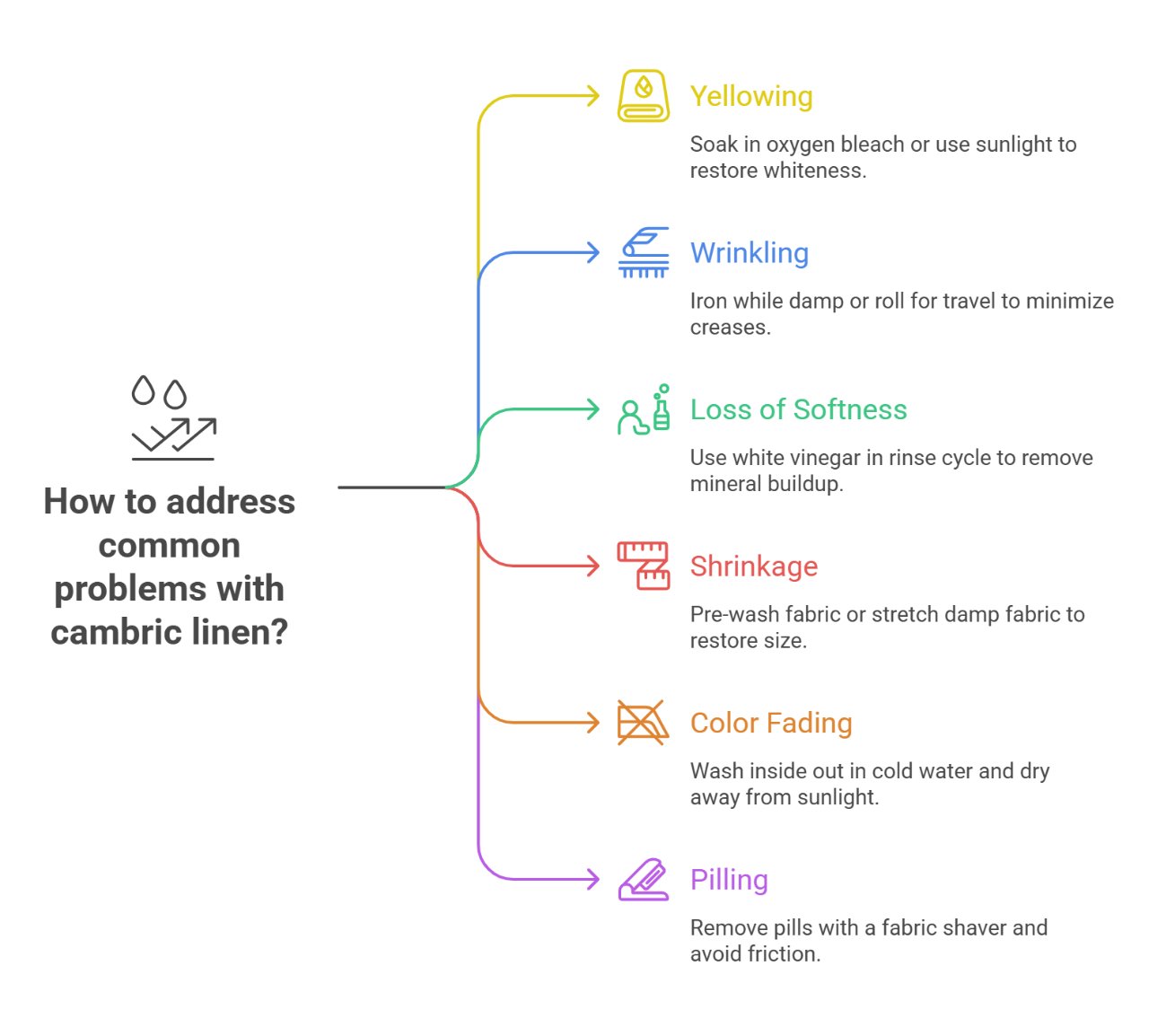
Even with proper care, issues occasionally arise with cambric fabric. Here’s how to address common problems.
Problem: Yellowing Over Time
Cause: Natural linen fibers can yellow due to age, improper storage, or exposure to light and air. Residual detergent and fabric softener also contribute to yellowing.
Solutions: Soak yellowed items in a solution of oxygen bleach and cool water for several hours. For stubborn yellowing, try laying damp fabric in direct sunlight – the natural bleaching effect of UV light can restore whiteness. Prevention works better than correction, so store clean cambric away from light and use minimal detergent.
Problem: Excessive Wrinkling
Cause: While cambric resists wrinkles better than regular linen, it still creases with wear and washing. Over-drying and leaving items bunched in the dryer worsens wrinkling.
Solutions: Remove items from the washing machine promptly and shake them out before hanging or laying flat to dry. Iron while slightly damp for easier wrinkle removal. For travel, roll garments instead of folding to minimize creases. A light starch spray can add wrinkle resistance if you prefer a crisper look.
Problem: Loss of Softness After Washing
Cause: Hard water leaves mineral deposits that stiffen fabric. Using too much detergent or the wrong water temperature also affects softness.
Solutions: Add white vinegar (1/2 cup) to the rinse cycle – it acts as a natural fabric softener and removes mineral buildup. Avoid commercial fabric softeners, which coat fibers and reduce absorbency. If you have very hard water, consider installing a water softener or using distilled water for delicate items.
Problem: Shrinkage Beyond Expected Range
Cause: Hot water, high dryer heat, or agitation exceeding fabric capacity cause excessive shrinkage. Some fabrics aren’t pre-shrunk during manufacturing.
Solutions: Pre-wash fabric before cutting for sewing projects. Accept that some shrinkage is normal (3-5%) with natural fibers. To potentially restore size, gently stretch damp fabric back to shape and secure it with pins while air-drying. This doesn’t always work but is worth trying on valuable items.
Problem: Color Fading
Cause: UV light, chlorine, and harsh detergents break down fabric dyes. Natural plant-based dyes fade more quickly than synthetic dyes.
Solutions: Wash colored cambric inside out in cold water. Dry away from direct sunlight. Use color-safe detergents without optical brighteners. Store colored items in dark locations. Accept that some fading adds character to natural fabrics – many people prefer the lived-in look of gently faded linen.
Problem: Pilling
Cause: Friction from wear causes loose fiber ends to ball up on the surface. Lower-quality cambric with shorter fibers pills more readily.
Solutions: Remove pills gently with a fabric shaver or sweater stone. Turn garments inside out before washing to reduce friction. Avoid wearing cambric items with rough-textured accessories or under abrasive backpack straps. Good-quality cambric should pill minimally.
Frequently Asked Questions
About the Author
Sarah Mitchell is a textile specialist with over 15 years of experience in fabric manufacturing and quality assessment. She holds a degree in Textile Engineering and has worked with both European linen mills and American cotton producers. Sarah regularly consults for fashion designers and home décor companies on fabric selection and care. Her expertise includes natural fiber identification, textile testing standards, and sustainable fabric production methods.
Final Thoughts
Cambric linen occupies a special place in the textile world. Its combination of smooth texture, natural breathability, and refined appearance makes it perfect for situations where comfort meets elegance. The fabric’s 400-year history proves its lasting appeal, while modern manufacturing maintains quality standards that professional tests can verify.
The investment in quality cambric pays off through longevity and performance. While initial costs exceed standard cotton, proper care allows cambric items to last years or even decades. The fabric becomes softer and more comfortable with age, unlike synthetics that deteriorate. For summer wardrobes, formal occasions, and fine home textiles, cambric delivers value that cheaper alternatives can’t match.
Key Takeaways
- Choose cambric for summer clothing where breathability and moisture management matter most. The natural temperature regulation keeps you comfortable in hot weather better than synthetic alternatives.
- Consider cotton-linen blends for everyday use if pure linen cambric exceeds your budget. Blends capture many benefits at lower cost while still providing natural fiber advantages.
- Pre-wash before sewing projects to handle shrinkage upfront. The 3-5% shrinkage is normal but can ruin careful measurements if ignored.
- Use cold water and gentle cycles for washing to preserve fabric quality. Harsh treatment breaks down natural fibers faster than necessary wear.
- Accept some wrinkling as part of natural fabric’s character rather than fighting it constantly. The relaxed look of slightly rumpled cambric has its own appeal.
- Verify thread count and fiber content when purchasing to ensure you’re getting actual cambric rather than synthetic imitations labeled as “linen-look.”
- Store properly in cool, dark, dry conditions using breathable storage materials to maintain quality between uses.
- Consider cambric’s limitations honestly – it’s not suitable for heavy-duty use, cold weather, or situations requiring minimal maintenance.
When to Choose Cambric
Select cambric when you need lightweight fabric with refined appearance for warm weather or indoor wear. The investment makes sense for:
- Summer dress shirts and formal blouses where professional appearance matters
- Special occasion clothing including wedding attire and christening gowns
- Quality table linens for elegant dining experiences
- Embroidery projects requiring stable, smooth base fabric
- Baby clothing where natural, gentle textiles protect sensitive skin
- Heirloom pieces designed to last through generations
When to Choose Alternatives
Look at other fabrics when your needs don’t align with cambric’s strengths:
- Heavy upholstery or outdoor gear requires more durable materials
- Cold weather clothing needs insulating properties cambric lacks
- Children’s play clothes benefit from more forgiving care requirements
- Budget constraints make cotton or cotton poplin more practical choices
- You need wrinkle-free appearance without ironing – consider cotton-polyester blends
Looking Forward
As fashion moves toward sustainable choices and quality over quantity, cambric fits well with these values. The fabric’s natural origins, biodegradability, and longevity align with reduced-waste lifestyles. While fast fashion emphasizes disposable clothing, investing in quality cambric pieces supports a more thoughtful approach to building a wardrobe.
Modern manufacturing continues improving cambric production efficiency while maintaining traditional quality. New testing standards ensure consistency across suppliers. Increased consumer interest in natural fibers drives innovation in finishing techniques and sustainable production methods.
Whether you’re sewing your own garments, selecting ready-made clothing, or choosing textiles for your home, understanding cambric helps you make informed decisions. The fabric’s unique combination of properties serves specific needs better than alternatives. With proper selection, care, and realistic expectations, cambric linen delivers comfort, beauty, and performance that justify its premium position in the textile market.

